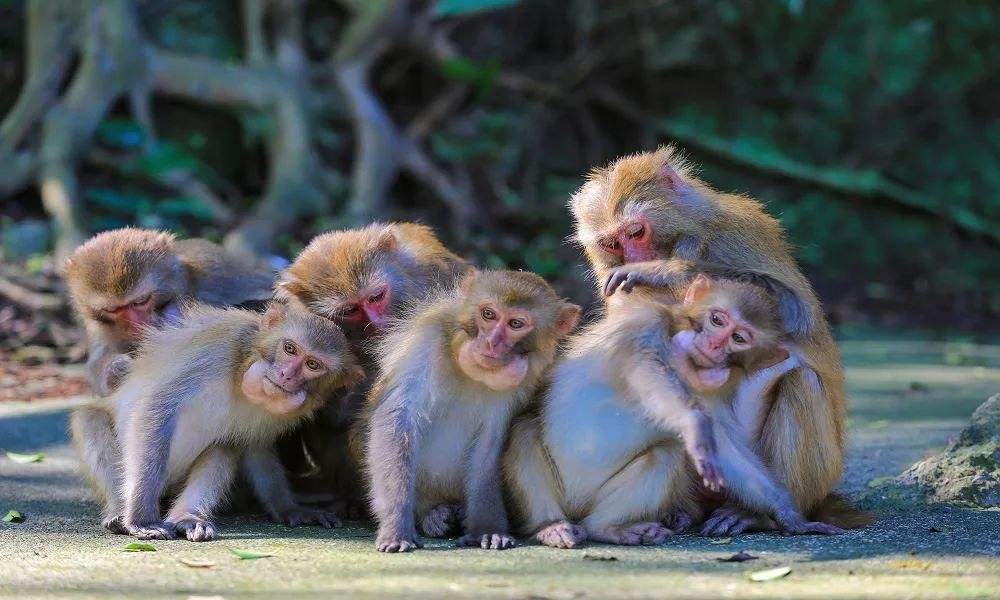Macaca
IUCN
LCBasic Information
Feature
The most common monkey in nature
Distribution and Habitat
Origin: Afghanistan, Bangladesh, Bhutan, China, India, Lao People's Democratic Republic, Myanmar, Nepal, Pakistan, Thailand and Vietnam.
Introduction: Hong Kong, China, United States (Florida).
It inhabits tropical, subtropical and warm temperate broad-leaved forests, from low hills to 3000-4000 meters high altitude, secluded and food-rich environments. It is one of the existing primates with lower requirements for habitat conditions. It likes to live in the forest and shrub areas of rocky mountains, especially those vast areas with rugged rocks, cliffs, streams, valleys, climbing vines and green trees, which are often the most ideal living places for monkeys.
Appearance
The individual is slightly smaller than other monkeys of the same genus, with a thin face, no whorls of hair radiating from the top of the head, brown in color, slightly protruding forehead, high brow bones, deep eye sockets, cheek pouches, short shoulder hair, and a long tail, which is about half the length of the body. Most of its hair is grayish yellow and grayish brown, the back is brownish gray or brownish yellow, the area below the waist is orange-yellow or orange-red, the belly is light grayish yellow and shiny, and the legs on the chest and abdomen are darker gray. The body color often varies between different regions and individuals. The face and ears are mostly flesh-colored, and the buttocks are well developed and mostly flesh-red. The adult male monkey is larger than the female monkey.
The snout is prominent, the jaws are thick, there are 32 teeth, the nostrils are close together facing forward and downward, and the hands and feet have 5 fingers and toes, with flat nails
Details
Macaques are the most common monkeys in nature, with 10 subspecies.

Like the US presidential election, the Monkey King is also "re-elected" every 4 years and can also be re-elected. The throne of the monkeys is created through fierce struggles and fights between the strong. When the term of each monkey king is about to expire, those male monkeys who feel that they have competitive strength are eager to try, and they will raise their tails in front of the monkey king, challenge the monkey king, and then fight with the monkey king. If they defeat the monkey king, they will compete with other challengers. After a life-and-death battle, the final winner will be the new monkey king. Those monkeys who were defeated were bloody, with broken limbs and lame legs. The monkey king who was driven off the stage was often expelled from the monkey group and became a lonely monkey and wandered around. This shows the cruelty in the competition for the monkey king.
The reason why the monkeys fought desperately for the throne was because the monkey king enjoyed privileges in the monkey group. The monkey king was very powerful during his reign. The monkeys must obey the monkey king and must not disobey him. If there is something delicious, the monkey king must always eat it first. The monkey king not only eats more and occupies more, but also enjoys the privilege of "polygamy". Most adult female monkeys are its "queens", so the monkey king has "three palaces and six courtyards, and a group of wives and concubines".
China is a rich country in macaque resources. More than 60% of the provinces (regions) have production. Although the distribution is uneven and the distribution area is not continuous, the distribution area is still quite wide. According to incomplete estimates and statistics of macaque resources in various places, the number of macaques in China is about 200,000. Among them, Guangdong Province, one of the main production areas, has about 10,000; Guangxi has about 30,000-50,000; Guizhou has about 30,000-50,000; Yunnan has about 50,000-60,000; and other regions have a total of about 30,000-40,000. According to the survey results of some regions, the macaque resources are at most only 20%-30% of the 40 or 50 years ago in the 20th century. The monkey sources in Guangdong, Guangxi, Hunan, Fujian, Henan and other places have declined the most, and many areas have even cut off monkey traces for many years.
Indiscriminate hunting is the main factor that endangers macaques. In the 1950s, there were many monkey-producing areas in China, and the number of monkeys was large, so there were monkeys coming down the mountain to destroy crops. In order to protect crops, the masses tried every means to organize hunting, and the relevant departments organized a large number of purchases and exports, resulting in fatal damage to macaque resources. Since then, although in principle only the offspring of artificial breeding can be exported, the annual export volume is still considerable. In the seven years from 1983 to 1992, the annual import and export report figures of the International Convention on Endangered Species of Wild Fauna and Flora showed that some developed countries imported about 8,000 macaques from China, an average of more than 1,000 per year.
Currently, artificial breeding research has been carried out all over the world. The United States has established 7 primate research centers. my country has also established a primate center in Xishuangbanna, and has established artificial breeding farms in Kunming, Shanghai, Beijing and other places.
Listed in China's "National Key Protected Wildlife List" as a national second-level protected animal.
Listed in the "China Red Book of Endangered Animals·Mammals" as a vulnerable species.
Listed in the 2008 Red List of Endangered Species of the World Conservation Union (IUCN) ver 3.1-Low Risk (LC).
Protect wild animals and stop eating game.
Maintaining ecological balance is everyone's responsibility!








